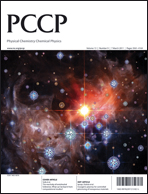1,2,3-Benzodithiazolyl, 2,1,3-benzothiaselenazolyl and 1,2,3-benzodiselenazolyl radicals were generated by the reduction of the corresponding cations and investigated by pulse EPR and ENDOR in frozen CHCl3 solutions at 30 and 80 K. These methods, in combination with density functional theory calculations, were used to study the magnetic parameters of the radicals, namely the principal values of the nitrogen and proton hyperfine interactions and g-tensors. The spin density distribution was shown to be nearly the same for all investigated radicals and, therefore, replacement of sulfur by selenium leads to a limited perturbation of the radicals’ electronic structure. A high anisotropy of the g-tensors was found for the selenium-containing radicals.
You have access to this article
 Please wait while we load your content...
Something went wrong. Try again?
Please wait while we load your content...
Something went wrong. Try again?


 Please wait while we load your content...
Please wait while we load your content...